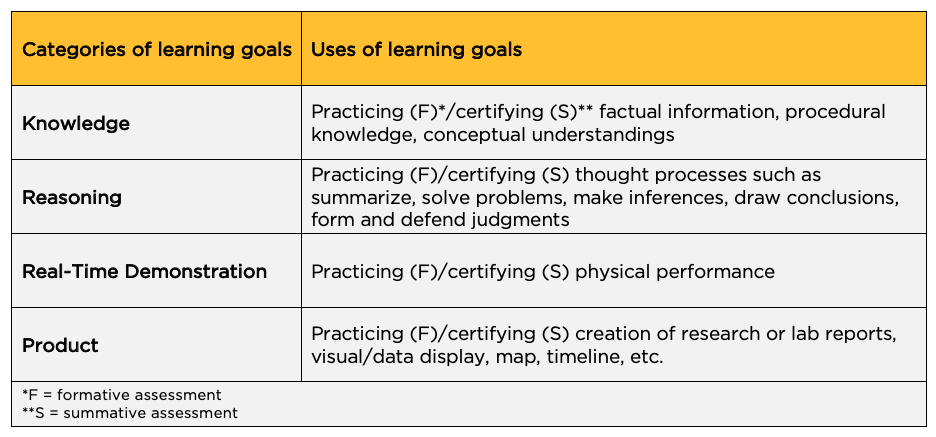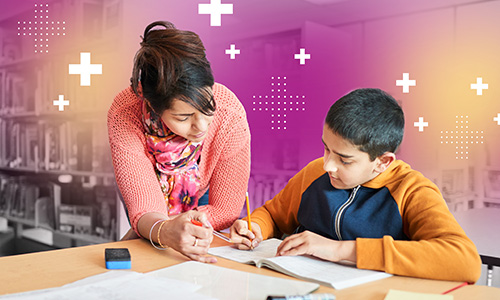I bet you’re often inundated with advertisements for digital learning tools, yet often do not have the time to process all the options. Let me help you cut through the noise and save time by providing guidance on how to use digital tools that fall into specific learning goal categories.
This post will help you start at the end—with the learning goal—and walk you through how to backtrack and identify the right tool to get you there. First, let’s level set by discussing three important ideas.
Learning goals are required
As you know, sets of learning goals (e.g., content standards) come from your state’s department of education or your school’s accreditation organization. There are different words for learning goals. For example, some schools or districts call them “prioritized standards,” “objectives,” or “essential learning.”
While the terminology can differ, the bottom line remains the same: We must make sure that there are clear, rigorous, 21st-century learning goals set for our students. It is then that we can pick digital learning tools that will best help meet those goals.
Digital learning tool purposes vary
There can be different reasons for using digital tools. They can be used to increase learner engagement, morale, and community, which is extremely important for cultivating robust, collaborative learning environments. In this blog post, I am emphasizing the purpose of choosing digital learning tools that are aligned to learning goals. However, keep in mind that when we effectively choose digital tools that support students in interacting with, practicing, and attaining rigorous learning goals, we are also building engagement, morale, and community.
I’ll focus on four learning goal categories
There are different ways to categorize learning goals. To be as universal and succinct as possible, I am using four general learning goal categories adapted from Classroom Assessment for Student Learning. See the chart below for a quick visual that summarizes them: Knowledge, Reasoning, Real-Time Demonstration, and Product.
We can use these four “buckets” to categorize learning goal information and skill expectations. Especially when pressed for time and energy (or when bombarded with so many digital tool choices), using these four categories can help you make sure you select the digital learning tools that will best support students to practice and achieve the learning goals.

When you’re ready to explore your goals
When you’re ready to explore specific goals for your students, I encourage you to try using the chart above to categorize a few of your class’s learning goals. If you need step-by-step help for how to categorize learning goals, try the following. I encourage you to reach out to an instructional leader, too.
- Examine your learning goals one at a time. Look for the action expectations (which can be understood by examining the verbs) as well as the content expectations (which can be understood by examining the noun phrases). Here’s an example: Explain specific roles and responsibilities of citizens (such as voters, jurors, taxpayers, members of the armed forces, petitioners, protesters, and officeholders). Here the action is “explain.” The content is “specific roles and responsibilities of citizens.”
- Ask yourself, “In which category does this goal belong?” This is the category to which you must scaffold instruction. Yes, there probably will be underpinning information needed first, which will fall in the Knowledge category, but the aim is to build toward the ultimate expectation. In the example from earlier, the ultimate learning goal category could be Reasoning because students are expected to exercise a thought process to explain specific citizen roles. The students will need to independently demonstrate that they can put pieces of knowledge together to form an explanation. If the learning goal stated that the students must deliver their explanation in a formal speech, then the ultimate category would be Real-Time Demonstration. If the learning goal called for a research paper, then the ultimate category would be Product.
- Look to the learning progression if you get stuck. If you’re having trouble categorizing a learning goal, look at the learning progression. Learning progressions are charts that show when learning goals appear across grades and how the learning goal develops across grades. Learning progression charts can often be found in the appendix of learning goal documents or on the website of standard experts (like on Achieve the Core). By looking at how a goal builds up and extends past the grade level of your students, you can gain clarity about learning goal expectations.
When you’re clear on your learning goal’s category
Once you feel confident that a learning goal is in the right category, you can choose the digital learning tools that will best support students to build up to or practice a skill (you can evaluate this with formative assessment) and then demonstrate the learning goal is met (summative assessment will let you know they’ve gotten there). If needed, an instructional leader can help you determine which digital tools are free or paid for by your district or school and choose the ones that best match the complexity demands of your prioritized learning goal.
Let’s work with the learning goal example from before: Explain specific roles and responsibilities of citizens (such as voters, jurors, taxpayers, members of the armed forces, petitioners, protesters, and officeholders). Here is one teacher’s explanation of how she used formative and summative digital tools with this goal:
“When using this Reasoning goal with eighth-grade students, I first used several digital formative tools, including Kahoot! quizzes, to build the underpinning skills needed to be successful with the Reasoning task. For example, after an exercise such as discussing a Newsela article about the roles and responsibilities of voters, I then used Kahoot! to check for students’ understanding and patterns of thinking regarding voting and voters. I would also ask students to work with partners to create and turn in Kahoot! questions for future games reviewing the article.
“After building those underpinning skills with formative tools, I engaged students with practicing parts of the Reasoning tasks they would need to put together for the Reasoning summative. For example, I created a Google Doc handout that students worked on with a partner. In it, they were guided to respond to rights and responsibilities scenarios; this allowed them to put the rights and responsibilities information pieces together into an explanation. Pairs then submitted their Google Doc back to me, and I used the comment feature to give feedback about how the explanation could be strengthened (e.g., be more accurate and specific). The following day, students used the feedback to improve their responses.
“On the summative, students received new scenarios with a new Google Doc handout. They applied all that we practiced to show that they could independently explain specific roles and responsibilities of citizens by responding to the scenarios. Through the practice and use of formative as well as summative digital tools that matched the learning goal, my students demonstrated that they could move past the Knowledge category and independently succeed with the Reasoning expectations of the learning goal.”
Ready for next steps?
As you prepare to do this work in your classroom, I want to validate that using just a few best-fit digital learning tools is plenty. You can positively impact learning by leveraging a small number of best-fit digital tools. You can also put students to work maximizing the positive impact of the digital tools’ learning benefits and learning team culture. For example, I would have my eighth-graders make Kahoot! quizzes to demonstrate their own knowledge and then share their quiz with peers. Or I would have my students make screencasts to explain a process that showed me their learning and could be shared with others (with the student’s permission) to clarify or deepen understanding.
Give yourself some breathing room by putting students to work deeply exploring just a few digital learning tools that are best for the expectations of the learning goals.








